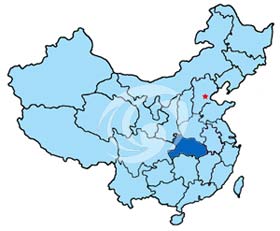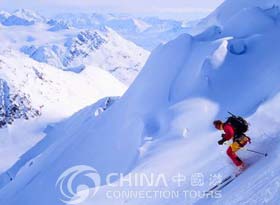 Hubei is situated in central China, and watered by two major river systems – the Yangtze and Hanjiang. The Jianghan Plain takes up most of central and eastern Hubei, while the west and the peripheries are more mountainous, with ranges such as the Wudang Mountains, the Jingshan Mountains, the Daba Mountains, and the Wushan Mountains (in rough north-to-south order). The Dabie Mountains lie to the northeast, on the border with Henan and Anhui; the Tongbai Mountains lie to the north on the border with Henan; to the southeast the Mufu Mountains form the border with Jiangxi. The eastern half of the Three Gorges (Xiling Gorge and part of Wu Gorge) lies in western Hubei; the other half is in neighboring Chongqing. The highest peak in Hubei is Shennong Peak, found in the Daba Mountains and in the forestry area of Shennongjia; it has an altitude of 3105 m.
Hubei is situated in central China, and watered by two major river systems – the Yangtze and Hanjiang. The Jianghan Plain takes up most of central and eastern Hubei, while the west and the peripheries are more mountainous, with ranges such as the Wudang Mountains, the Jingshan Mountains, the Daba Mountains, and the Wushan Mountains (in rough north-to-south order). The Dabie Mountains lie to the northeast, on the border with Henan and Anhui; the Tongbai Mountains lie to the north on the border with Henan; to the southeast the Mufu Mountains form the border with Jiangxi. The eastern half of the Three Gorges (Xiling Gorge and part of Wu Gorge) lies in western Hubei; the other half is in neighboring Chongqing. The highest peak in Hubei is Shennong Peak, found in the Daba Mountains and in the forestry area of Shennongjia; it has an altitude of 3105 m.
The Yangtze River enters Hubei from the west via the Three Gorges; the Hanshui enters from the northwest. These two rivers meet at Wuhan, the provincial capital. Thousands of lakes dot the landscape, giving Hubei the name "Province of Lakes." The largest of these lakes are Lake Liangzi and Lake Honghu. The Danjiangkou Reservoir lies on the border between Hubei and Henan Provinces.
Hubei has a subtropical monsoon climate. It enjoys abundant sunlight, with temperatures on the high side. The annual temperature averages between 13-18C (52-66F). The highest temperature can reach 41C (106F), while the lowest temperature can drop to -14.9C (6F). The short frost period and abundant precipitation are favorable for agriculture. There are 230 to 300 days free of frost in a year and the annual rainfall has stood at 1,182.3 mm for many years. But rainfall is unevenly distributed. The amount of precipitation in the Wuling mountainous area is as high as 1,600-1,700 mm, while that in west Hubei is as low as 700-800 mm. Wuhan, its capital, is one of the hottest places in China.
 People in Hubei speak Mandarin dialects. The most celebrated element of Hubei cuisine is the Wuchang fish, a freshwater bream that is commonly steamed. Types of traditional Chinese opera popular in Hubei include Hanju and Chuju.
People in Hubei speak Mandarin dialects. The most celebrated element of Hubei cuisine is the Wuchang fish, a freshwater bream that is commonly steamed. Types of traditional Chinese opera popular in Hubei include Hanju and Chuju.
The Shennongjia area is the alleged home of the Yeren, a wild undiscovered hominid, similar to Big Foot (Sasquatch) in America, that lives in the forested hills.
The people of Hubei have been given the uncomplimentary nickname "Nine Headed Birds" by other Chinese, from a mythological creature said to be very aggressive and hard to kill. Wuhan University (founded in 1893) and many other institutions in Wuhan make it a hub of higher education and research in China
At the end of the year 2005, the total population in Hubei stood at 60.31 million. The Han people form the dominant ethnic group. A considerable Miao and Tujia population live in the southwestern part of the province, especially in the Enshi Tujia and Miao Autonomous Prefecture.
Hubei's offers tourists both beautiful landscapes and abundant places of historic and cultural interest. There are six national-level scenic spots, 13 national forest parks and three national nature reserves. Shennongjia has been listed in the UNESCO's program of Man and Biosphere and Wudang Mountain is on the list of World Cultural and Natural Heritage sites. The Three Gorges of the Yangtze River, Yellow Crane Tower and Gezhouba have been listed among China's top 40 tourist scenic sports. Hubei offers a plethora of historical and cultural sites.

